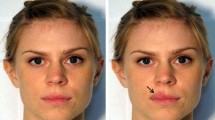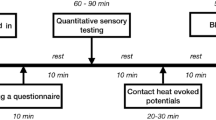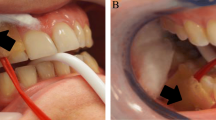Abstract
Objectives
The aims were to use different techniques to assess the degree of sensory changes and magnitude of perceived size changes in the facial region induced by nerve blocks of two different trigeminal nerve branches in healthy participants.
Materials and methods
This placebo-controlled study included 30 healthy volunteers. The participants underwent quantitative and qualitative sensory testing (QST and QualST) thrice: before, 10 min, and 2 h after mental (n = 15) and infraorbital (n = 15) nerve blocks and during control (saline) sessions. Perceived numbness, temperature changes, and perceptual distortion were also measured at all time points during the nerve block and control sessions. Differences in outcome parameters between the sessions and time points were analyzed using analyses of variance and McNemar’s tests.
Results
There was a significant degree of sensory loss to most QST and all QualST parameters, with significant numbness and increased perceived size at the injection site 10 min and 2 h after the nerve blocks compared with saline (P < 0.030) and the baseline (P < 0.042). Two hours after the nerve blocks, the sensitivity was significantly closer to baseline than after 10 min to most of the QST parameters (P < 0.011).
Conclusions
QST and QualST revealed that the nerve blocks in the orofacial region resulted in complete or partial blockade of afferent nerve fibers mediating thermal and mechanical function for more than 2 h with significant numbness and perceptual distortion.
Clinical relevance
Both QST and QualST can provide information on the degree of blockade of afferent nerve fibers after nerve blocks in the orofacial region.






Similar content being viewed by others
References
List T, Mojir K, Svensson P, Pigg M (2014) A new protocol to evaluate the effect of topical anesthesia. Anesth Prog 61:135–144
Pere P, Iizuka T, Rosenberg PH, Lindqvist C (1992) Topical application of 5% eutectic mixture of lignocaine and prilocaine (EMLA) before removal of arch bars. Br J Oral Maxillofac Surg 30:153–156
Lee J, Lee JY, Kim HJ, Seo KS (2016) Dental anesthesia for patients with allergic reactions to lidocaine: two case reports. J Dent Anesth Pain Med 16:209–212
List T, Leijon G, Helkimo M, Oster A, Svensson P (2006) Effect of local anesthesia on atypical odontalgia—a randomized controlled trial. Pain 122:306–314
Gremeau-Richard C, Dubray C, Aublet-Cuvelier B, Ughetto S, Woda A (2010) Effect of lingual nerve block on burning mouth syndrome (stomatodynia): a randomized crossover trial. Pain 149:27–32
Boyce RA, Kirpalani T, Mohan N (2016) Updates of topical and local anesthesia agents. Dent Clin N Am 60:445–471
Zhou P, Chen Y, Zhang J, Wang K, Svensson P (2018) Quantitative sensory testing for assessment of somatosensory function in human oral mucosa: a review. Acta Odontol Scand 76:13–20
Agbaje J, De Laat A, Constantinus P, Svensson P, Baad-Hansen L (2017) Agreement between quantitative and qualitative sensory testing of changes in oro-facial somatosensory sensitivity. J Oral Rehabil 44:30–42
Rolke R, Baron R, Maier C, Tolle TR, Treede RD, Beyer A, Binder A, Birbaumer N, Birklein F, Botefur IC, Braune S, Flor H, Huge V, Klug R, Landwehrmeyer GB, Magerl W, Maihofner C, Rolko C, Schaub C, Scherens A, Sprenger T, Valet M, Wasserka B (2006) Quantitative sensory testing in the German research network on neuropathic pain (DFNS): standardized protocol and reference values. Pain 123:231–243
Maier C, Baron R, Tolle TR, Binder A, Birbaumer N, Birklein F, Gierthmuhlen J, Flor H, Geber C, Huge V, Krumova EK, Landwehrmeyer GB, Magerl W, Maihofner C, Richter H, Rolke R, Scherens A, Schwarz A, Sommer C, Tronnier V, Uceyler N, Valet M, Wasner G, Treede RD (2010) Quantitative sensory testing in the German Research Network on Neuropathic Pain (DFNS): somatosensory abnormalities in 1236 patients with different neuropathic pain syndromes. Pain 150:439–450
Kothari SF, Baad-Hansen L, Hansen LB, Bang N, Sorensen LH, Eskildsen HW, Svensson P (2016) Pain profiling of patients with temporomandibular joint arthralgia and osteoarthritis diagnosed with different imaging techniques. J Headache Pain 17:61
Kothari SF, Baad-Hansen L, Oono Y, Svensson P (2015) Somatosensory assessment and conditioned pain modulation in temporomandibular disorders pain patients. Pain 156:2545–2555
Baad-Hansen L, Pigg M, Ivanovic SE, Faris H, List T, Drangsholt M, Svensson P (2013) Intraoral somatosensory abnormalities in patients with atypical odontalgia—a controlled multicenter quantitative sensory testing study. Pain 154:1287–1294
Yang G, Baad-Hansen L, Wang K, Fu K, Xie QF, Svensson P (2016) Somatosensory abnormalities in Chinese patients with painful temporomandibular disorders. J Headache Pain 17:31
Said Yekta-Michael S, Stein JM, Marioth-Wirtz E (2015) Evaluation of the anesthetic effect of epinephrine-free articaine and mepivacaine through quantitative sensory testing. Head Face Med 11:2
Baad-Hansen L, Pigg M, Ivanovic SE, Faris H, List T, Drangsholt M, Svensson P (2013) Chairside intraoral qualitative somatosensory testing: reliability and comparison between patients with atypical odontalgia and healthy controls. J Orofac Pain 27:165–170
Turker KS, Yeo PL, Gandevia SC (2005) Perceptual distortion of face deletion by local anaesthesia of the human lips and teeth. Exp Brain Res 165:37–43
Dagsdottir LK, Skyt I, Vase L, Baad-Hansen L, Castrillon E, Svensson P (2015) Experimental orofacial pain and sensory deprivation lead to perceptual distortion of the face in healthy volunteers. Exp Brain Res 233:2597–2606
Dagsdottir LK, Skyt I, Vase L, Baad-Hansen L, Castrillon E, Svensson P (2016) Reports of perceptual distortion of the face are common in patients with different types of chronic oro-facial pain. J Oral Rehabil 43:409–416
Skyt I, Dagsdottir L, Vase L, Baad-Hansen L, Castrillon E, Roepstorff A, Jensen TS, Svensson P (2015) Painful stimulation and transient blocking of nerve transduction due to local anesthesia evoke perceptual distortions of the face in healthy volunteers. J Pain 16:335–345
Sato H, Castrillon EE, Cairns BE, Bendixen KH, Wang K, Nakagawa T, Wajima K, Svensson P (2015) Intramuscular temperature modulates glutamate-evoked masseter muscle pain intensity in humans. J Oral Facial Pain Headache 29:158–167
Pigg M, Baad-Hansen L, Svensson P, Drangsholt M, List T (2010) Reliability of intraoral quantitative sensory testing (QST). Pain 148:220–226
Rolke R, Magerl W, Campbell KA, Schalber C, Caspari S, Birklein F, Treede RD (2006) Quantitative sensory testing: a comprehensive protocol for clinical trials. Eur J Pain 10:77–88
McHugh ML (2012) Interrater reliability: the kappa statistic. Biochem Med (Zagreb) 22:276–282
Costa YM, Castrillon EE, Bonjardim LR, Rodrigues Conti PC, Baad-Hansen L, Svensson P (2017) Effects of experimental pain and lidocaine on mechanical somatosensory profile and face perception. J Oral Facial Pain Headache 31:115–123
Honda M, Baad-Hansen L, Iida T, Dagsdottir LK, Komiyama O, Kawara M, Svensson P (2017) Perceptual distortion of the tongue by lingual nerve block and topical application of capsaicin in healthy women. Clin Oral Investig 21:2045–2052
Svensson P, Baad-Hansen L, Pigg M, List T, Eliav E, Ettlin D, Michelotti A, Tsukiyama Y, Matsuka Y, Jaaskelainen SK, Essick G, Greenspan JD, Drangsholt M (2011) Guidelines and recommendations for assessment of somatosensory function in oro-facial pain conditions—a taskforce report. J Oral Rehabil 38:366–394
Barcohana N, Duperon DF, Yashar M (2003) The relationship of application time to EMLA efficacy. J Dent Child (Chic) 70:51–54
Meechan JG (2008) Intraoral topical anesthesia. Periodontol 2000 46:56–79
Krumova EK, Zeller M, Westermann A, Maier C (2012) Lidocaine patch (5%) produces a selective, but incomplete block of Adelta and C fibers. Pain 153:273–280
Malamed SF (2013) Clinical actions of specific agents. In: Malamed S (ed) Handbook of local anesthesia, 6th edn. Elsevier, St. Louis, pp 52–75
Baad-Hansen L, Benoliel R (2017) Neuropathic orofacial pain: facts and fiction. Cephalalgia 37:670–679
Gandevia SC, Phegan CM (1999) Perceptual distortions of the human body image produced by local anaesthesia, pain and cutaneous stimulation. J Physiol 514(Pt 2):609–616
Dagsdottir LK, Bellan V, Skyt I, Vase L, Baad-Hansen L, Castrillon E, Svensson P (2018) Multisensory modulation of experimentally evoked perceptual distortion of the face. J Oral Rehabil 45:1–8
Funding
This study was funded by the Danish Dental Association, Denmark.
Author information
Authors and Affiliations
Corresponding author
Ethics declarations
Conflict of interest
The authors declare that they have no conflict of interest.
Ethical approval
The study was approved by the Central Denmark Region ethics committee ref. no. 1-10-72-139-12. This study was performed in accordance with the 1964 Helsinki declaration and its later amendments or comparable ethical standards.
Informed consent
Informed consent was obtained from all individual participants included in the study.
Rights and permissions
About this article
Cite this article
Kothari, S.F., Shimosaka, M., Iida, T. et al. Quantitative and qualitative assessment of sensory changes induced by local anesthetics block of two different trigeminal nerve branches. Clin Oral Invest 23, 2637–2649 (2019). https://doi.org/10.1007/s00784-018-2695-4
Received:
Accepted:
Published:
Issue Date:
DOI: https://doi.org/10.1007/s00784-018-2695-4




